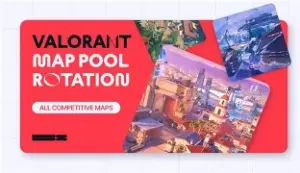Introduction
Valorant, Riot Games’ tactical first-person shooter, is constantly evolving to keep competitive play balanced and engaging. One of the most important elements shaping the game is the Valorant map pool. Riot regularly rotates maps in and out of competitive and esports play, ensuring variety, fresh strategies, and balanced gameplay. In this article, we’ll break down the current map pool, provide insights into their unique features, and analyze how each map fits into the competitive scene.
What is the Current Valorant Map Pool?
The current Valorant map pool determines which battlegrounds players encounter in ranked and professional play. Riot typically maintains seven active maps in the pool at a time, rotating older maps out for updates and reworks. This system keeps the game dynamic and prevents stagnation in both casual and esports environments.
Valorant Map Pool (As of September 2025)
Here’s the breakdown of the competitive map pool:
- Ascent – A classic Valorant map with open mid-control gameplay.
- Bind – Famous for its teleporters and unique site entry dynamics.
- Haven – The only three-site map in the pool, requiring adaptive strategies.
- Lotus – Known for its rotating doors and multi-path entries.
- Sunset – One of the newest maps, set in a cityscape with chokepoints and tactical angles.
- Icebox – A vertical, high-aim duel map demanding precise coordination.
- Split – Recently reintroduced, featuring tight corridors and vertical play.
Each map provides a distinct tactical experience, ensuring players must adapt their strategies for different setups and agent compositions.
Why Does Riot Rotate Maps?
Riot rotates maps in the Valorant map pool for several reasons:
- Freshness – To prevent repetitive strategies and stale gameplay.
- Balance Adjustments – Rotated maps are updated to improve design and competitive fairness.
- Esports Diversity – Pro play thrives on variety, testing teams across different styles.
- Player Engagement – Keeps casual and ranked modes exciting with new challenges.
Map-by-Map Analysis
1. Ascent
- Central mid-control focus.
- Wide open areas allow for operator usage.
- Balanced for attackers and defenders, making it a staple map.
2. Bind
- Teleporters create fast rotations and mind games.
- Smaller in size but tactically versatile.
- Requires agents with strong site-entry abilities.
3. Haven
- Unique with three bombsites.
- Encourages split-push tactics.
- Defenders must spread resources, creating openings for attackers.
4. Lotus
- Rotating doors add creative movement.
- Multiple entry points for site executions.
- Demands excellent communication and adaptability.
5. Sunset
- Riot’s fresh addition to the pool.
- Combines tight chokepoints with open fight zones.
- Perfect for balanced team compositions.
6. Icebox
- Vertical gameplay stands out.
- Demands sharp aim and quick decision-making.
- Suits duelists and controllers for site execution.
7. Split
- Features elevated platforms and tight choke areas.
- Mid-control is critical for attackers.
- Known for rewarding defensive holds.
The Role of Maps in Valorant Meta
Maps shape the Valorant meta by influencing which agents shine. For example:
- Controllers like Omen and Viper dominate on maps with many choke points (Split, Icebox).
- Initiators like Sova and Skye thrive in larger spaces (Ascent, Haven).
- Sentinels excel in maps with multiple sites to defend (Haven, Lotus).
Thus, the map pool directly affects team compositions and pro-level strategies.
Esports Impact of the Valorant Map Pool
The Valorant Champions Tour (VCT) and other tournaments are deeply impacted by map rotations. Teams prepare map-specific strategies, and certain rosters gain advantages on maps that suit their playstyle. Rotations force adaptability, ensuring no single strategy dominates the meta for too long.
How Players Can Adapt to the Map Pool
To stay competitive in ranked or esports, players should:
- Learn callouts for each map.
- Master a few agents tailored to different maps.
- Watch pro matches to study strategies.
- Practice utility lineups for smoke, flashes, and recon abilities.
Future of Valorant Maps
Riot has confirmed that the map pool will continue rotating. Players can expect periodic reworks of old favorites like Breeze or Fracture, alongside new map releases. This ensures Valorant remains fresh, challenging, and strategically deep.
Conclusion
The current Valorant map pool shapes the game’s tactical depth, competitive fairness, and overall player experience. With maps like Ascent, Bind, Haven, Lotus, Sunset, Icebox, and Split, players face a constantly evolving battleground that rewards adaptability and teamwork. As Riot continues to rotate and refine maps, Valorant’s competitive scene will remain dynamic and exciting.
Also Read: Spell Wallet Daily Puzzle Combo 6/7 September 2025
